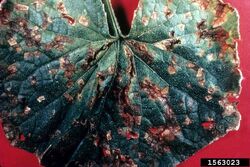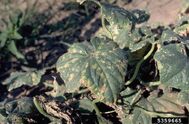| Pseudomonas | |
|---|---|
| Angular leaf spot of cucumber | |
 |
|
| A cucumber leaf showing signs of angular leaf spot caused by Pseudomonas amygdali pv. lachrymans | |
| Scientific Classification | |
| Kingdom: | Bacteria |
| Phylum: | Proteobacteria |
| Class: | Gamma Proteobacteria |
| Order: | Pseudomonadales |
| Family: | Pseudomonadaceae |
| Genus: | Pseudomonas |
| Species: | Pseudomonas amygdali |
| Pathovar: | Pseudomonas amygdali pv. lachrymans |
| Synonyms | |
| Angular leaf spot Angular leaf spot of Cucurbits |
|
Angular leaf spot of cucumber is caused by the pathogenic fungus Pseudomonas amygdali pv. lachrymans. It is most severe on cucumber, courgette, and honeydew melon but also can infect muskmelon, cantaloupe, watermelon, other squashes, pumpkin, and various gourds.[1]
Symptoms[]
Cucumber[]
Leaf symptoms appear as small, round to irregularly shaped, water-soaked lesions. The spots expand until they are limited by larger veins, which give the spots an angular appearance. Under humid conditions, water-soaked spots are covered by a white exudate, which eventually dries to form a thin, white crust on or adjacent to the spot on the underleaf surface. As the spots dry, they shrink and tear away from the healthy tissue, leaving large, irregular holes and giving the leaf a ragged and yellowish appearance.[1]
Squash & Watermelon[]
Squash and watermelon leaf lesions are more variable in size and are surrounded by yellow halos. The nearly circular, water-soaked spots on ripening fruit are much smaller than those on the foliage. Similar symptoms develop on musk melon leaves. These lesions eventually become chalky white and may crack open, allowing secondary fungi and bacteria to invade and cause a slimy, foul-smelling fruit rot.[1]
Prevention[]
Plant certified, pathogen-free seed produced in arid western locations. Resistant cucumber varieties are available. Do not grow cucurbits in the same field more than once every three or four years and avoid excessive nitrogen fertilization. Limit the use of overhead irrigation and avoid cultivating, harvesting, or otherwise handling plants when they are wet. Whereever feasible, cleanly plow under or collect and burn crop debris immediately after harvest. Apply a recommended bactericide at first sign of disease. Tank-mix the recommended bactericide with effective fungicides to protect the plants against fungal diseases.[1]
Examples[]
References[]
- ↑ a b c d (2010). Bacterial Disease - Angular Leaf Spot of Cucurbits - Pseudomonas syringae pv. lachrymans. Hort Answers. University of Illinois Extension. Retrieved: 2010-08-24.
